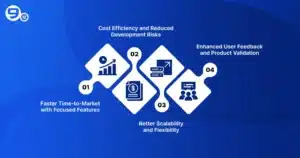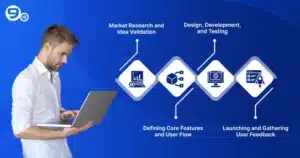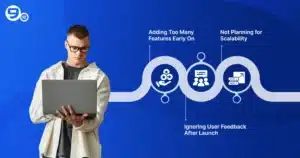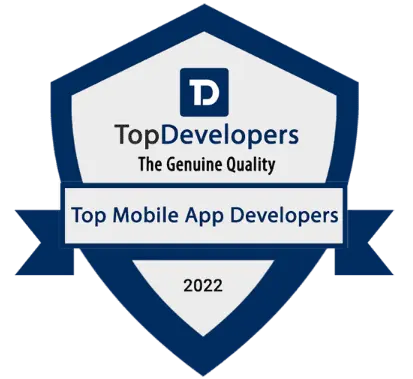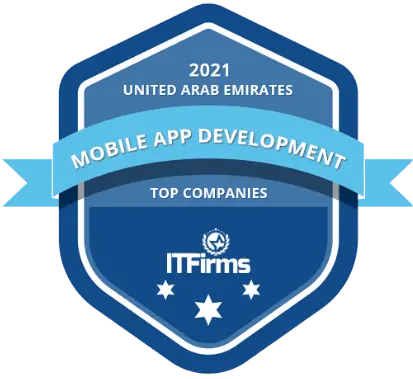Imagine that a startup founder has an amazing idea and decides to test it in the current market. Is it feasible to invest in a full-stack development without assessing the risk?
It may not be a good idea!
Most founders and tech teams are opting for custom MVP software development targeting specific features that align with business goals.
As the industry has grown to be more dynamic, delivering 10-minute services, smart investments, fintech, and others, custom MVP (Minimum Viable Product) development brings more flexibility to adapt to market changes. As enterprise software is anticipated to dominate the software development market, with a projected volume of $4.5 billion in 2025, the MVP approach mitigates financial risk.
Still confused about why to choose MVP software development? Let’s cover all those reasons why it is the smartest idea to launch your product and its benefits over other developments.
Understanding Custom MVP Software Development
Custom MVP software development refers to the process of building a product targeting specific needs for a business. Unlike regular software, this is built from scratch and helps to solve unique problems related to a specific type of user. Recently, with the popularity of software development, MVPs have focused on creating a product with minimal features that support users to experience software usage and test its functionalities.
Start Your MVP Software Development
Talk to our Experts
Request A Free Quote
In today’s market, there are good examples of successful products like Uber, Dropbox, or Instagram; these are made with the concept of custom MVP software development. Following the process provides faster idea validation to launch a product with early feedback for refining the quality of the software.
What is an MVP (Minimum Viable Product)?
For building an MVP, product managers do not aim to develop a perfect product rather focus on delivering a specific value to users. It is also known as the first tangible version of a product built using limited resources to depict the unique idea and project its practical use cases.
For example, any food delivery startup planning to launch its delivery in specific areas with limited drivers to check the number of orders generated within a month. Using MVP allows them to test for demand with consistent feedback. It helps businesses to generate insights relating to demographic and sales records. By releasing an MVP, it helps startups to launch software aligned with market needs and customer expectations.
The Difference Between Ready-Made and Custom MVPs
Readymade MVPs
Ready-made software is also known as an off-the-shelf product designed for commercial purposes and enterprise integration based on budget and pre-defined requirements. This software is built in a way to operate through a group of users for working repetitively on existing systems.
Key highlights:
- Ready-made MVPs are limited to the standard configuration only and resist massive changes.
- It is specifically designed for broader usage and restricted for generic purposes.
- These are easily available and installed without any costly migration.
-
Examples: QuickBooks, CRM platforms, Adobe, and Microsoft Office.
Custom MVPs
Custom-built MVPs are developed to meet specific business goals and market validation. Unlike traditional or ready-made MVPs, this is made from scratch as a blueprint for a unique idea using real-world cases. Here, the core vision is to understand user demand and not to build a final product.
Key highlights:
- Custom MVPs are highly flexible and scalable as per industry standards.
- It integrates for a specific purpose and business needs.
- Custom MVPs can be halfway or fully integrated through existing systems.
- Ideal for product differentiation with unique customized features.
Why Startups Prefer Custom MVP Development?
Startups are mainly early-stage businesses that aim to save their investment and resources across every domain. Opting for the MVP development is a cost-effective alternative and significantly reduces risks. As it is a launch for testing user experience, this build only includes essential features that minimize resource wastage. Using the MVP development, startups can shape a product journey through learning and improve it with user feedback based on data-driven insights.
During the building stage, startups want to attract investor interest using market validation for funding. Through MVP development, it creates a practical proof of the project’s feasibility and estimated revenue streams to secure financing for long-term growth.
Here are the following reasons why startups prefer custom MVP development:
- Growth & Stability: Startups look for customization due to changing market demands, and MVP development ensures scalability from initial development stages to remain relevant in the industry.
- Less Risk and Cost: Building a custom MVP requires fewer resources and investment, so even if the product fails in the market, startups can defer the loss with minimal risk.
- Improved customer experience: It ensures constant engagement among users to share valuable feedback on the product, which builds more trust and enhances funding negotiation.
- Encourage Agile Development: Most startups adopt an agile approach for regular check-ins and adjust changes based on project scope. Custom MVPs focus on product enhancements and iterative feedback to stand out from other competitors.
- Flexible Integration: Custom MVPs ease integration with third-party tools and cloud-based architecture using APIs and accessible tools to improve the product as the user demands.
Benefits of Custom MVP Software Development
From a product manager’s perspective, custom software development services go through strategic planning, market understanding, and agile execution. It benefits businesses in many other ways besides aligning with user expectations to build a scalable product. Here are the following benefits:
Faster Time-to-Market with Focused Features
Any startups looking for fast deployment with minimal features to test the market can get benefits from custom MVP software development. These products can easily be delivered to the market in shorter timelines of 1 to 3 months and quickly convert a product idea into reality. Due to these benefits, companies use it to deploy multiple products in different markets at once.
Cost Efficiency and Reduced Development Risks
Custom MVP software development will be the right-fit product for companies that want to pay only for specific features. This reduces cost wastage and risks at the development stages, making it a more feasible alternative. Businesses opting for offshore outsourcing for MVP further lower the cost burden.
Better Scalability and Flexibility
As the business scales in terms of user base and product types, a custom MVP has proven to be more flexible for adapting to changes. It swiftly fit into the market and aligned with new product features. The development team can be more selective in designing the product with their choice of technology stack and tool integration.
Enhanced User Feedback and Product Validation
One of the key advantages of opting for custom MVP development is product validation, which helps to add insights rather than making assumptions. It acts like a tool to gather end-user feedback with minimal effort and make better decisions for the future iteration without any significant investment. Regular feedback does not create a product gap and fits right into the market.
Better Resource Allocation
With MVP development, the software consists of minimal features to test for product capabilities that effectively utilize resources. Instead of full absorption of assets, this follows structured resource allocation to accomplish ideas without any wastage. Product managers will be more efficient in investing in acquiring external tools.
Better Financial Partnerships
Several times, product managers, while working on unique ideas, remain unsure about the final result and product performance. MVP development creates a testament for user experience to showcase in front of stakeholders and financial advisors. This helps to attract the best deals from investors and brand collaboration to capture the market.
How Custom MVP Development Supports a Smarter Launch?
Product failure is the biggest threat to founders in the era of a competitive market. So, how come custom MVP development is coming up as the smartest choice? As it builds a product after testing the market and user feedback preferences, this least reduces the failure risks.
Here is another reason to justify this being the smart decision:
Aligning MVP Goals with Business Objectives
Unlike generic MVPs, custom development does not follow a one-size-fits-all approach; this is more user goal-focused. Experts state that building an MVP doesn’t represent a minimized version of the product, but rather creates a base for accomplishing long-term product goals.
We can take the example of fintech software trying to test for any specific payment gateway; it will be the target business objectives. Now, the development team or outsourcing developers would only focus on the built-in limited features for MVP to accomplish that goal.
Adapting to Market Needs Quickly
The software market is dynamic, and businesses can’t rely on limited features; they look for custom development to pivot quickly. This approach accelerates adaptability to support companies in designing for flexibility, incorporating feedback, updating features, and following up on new trends.
Suppose a local baker aims to launch a custom MVP to target online ordering for cakes and pastries. After analysis, he found that the maximum users request same-day home delivery with custom cake designs. Now, the development team can integrate a system of automated customization to keep up with the pace of fast orders.
Building a Foundation for Future Growth
Every business aims to develop a full-scale product in the long run, while MVP development acts as a prototype for further improvements. Following this futuristic approach helps to ease navigation, scale up, and reduce technical debt based on a consistent user experience.
For example, a manufacturing company is building an MVP to track its local deliveries. After successfully developing the product, it can integrate with other systems of IoT tracking, AI optimization, analytics, and scale to global delivery without building this from scratch.
Steps Involved in Custom MVP Software Development
Whether your business is bootstrapping or collaborating with a custom software development company, there are certain processes they follow to build the right MVP. It is an effective long-run development roadmap that balances the software efficiency, speed, and constant improvement for features.
So, here are the following steps for building a custom MVP software development:
Market Research and Idea Validation
The first step is to start with basic market research to determine whether the idea is relevant in the market or not. It highlights the exact problem that your product is trying to solve for end users. Having a deep understanding of the market beforehand enables businesses to deliver the right product and achieve success for idea validation.
Defining Core Features and User Flow
Custom MVP development requires targeting a small set of features to reduce complexities for further advancements. The technical team can create a general roadmap with targeted milestones to track for each stage of building the right product. Also, it generates a user flow to guide their journey of using the product in the right way.
Design, Development
Next, the step followed is the UI/UX designing part to create a prototype or wireframe. Developers can try multiple intuitive designs for solving real problems and ease usability. Following an iterative cycle of build-measure-learn, the team might opt for an agile approach, low-code, or no-code development based on timelines.
Product Testing
For custom MVP software development, functional and non-functional testing are an unavoidable part of the process. So, the task assigned to the testing team is to gather feedback on functionalities and usage that highlight the scope of improvements. Other times, companies also test the product with select real users to understand their expectations.
Launching and Gathering User Feedback
Once you have successfully developed a custom MVP, it is ready to be launched in the targeted market for user feedback. By scanning the staging or production environment, the development team selects the alternative of manual or automated deployment through CI/CD pipelines to simplify the process.
Common Mistakes to Avoid During MVP Development
Launching a custom MVP product is a learning journey in itself that increases the risk of catching up with mistakes. Overlooking the development steps or missing out on a few principles, like research, can lead to mistakes that directly affect the product’s success rate. Here is are list of common mistakes to avoid for MVP development:
Adding Too Many Features Early On
An inexperienced development team might do over-engineering on the product, resulting in adding unnecessary features, inadequate scalability features, and complex infrastructure. These mistakes can increase the cost burden, bugs, impact software speed, and delay the project might risk the product’s success.
Ignoring User Feedback After Launch
Avoiding users’ feedback directly implies inviting product failure. As the ultimate aim for custom MVP software development is to gather users’ opinions, overlooked opinions can lead to missing the right market opportunities. If users feel dissatisfied or disconnected with your product, this will disrupt the entire post-launch phase.
Not Planning for Scalability
Launching an MVP software is not the ultimate step; it further increases the scope of advanced features. Skipping the scalability for development can be a costly mistake, as this creates additional technical burden on the team. It might create a situation where product sales drop after a market shift or users’ preferences.
Start Your MVP Software Development
Talk to our Experts
Request A Free Quote
Avoiding Market Research
Every idea looks unique in the room filled with tech experts; however, without its relevance to the market, it creates no use for business. So, skipping market research can be a huge mistake, as this implies high risk for the product to entirely depend on assumptions without any real data insights.
Relying on the Wrong Development Team
Every tech developer and expert is following their own development approach and hiring team without assessing their skills and experience for which could disrupt the final product. Outsourcing can increase the risk of data threats, and unstructured communication can lead to last-minute chaos and delay deployment.
Conclusion
Owning your business software sounds like a dream turning into reality. Business founders and the team spend years of research to execute an idea, where they prefer to avoid risk for their investment and resources. So, custom MVP software development is a viable alternative to build a feasible product without any compromise on quality.
Why Investing in Custom MVP Software Development is Worth it?
Businesses are gaining major benefits from custom MVP development for faster testing, minimizing risk, and making smart decisions. Delaying a software development project for a year creates a burden for cost and increases financial risks for the business. Shifting to custom development support for rapid prototyping, consistent improvement, and enabling deployment of the product within a fraction of the time. So, it is a more convenient choice to invest in MVP development to minimize cost while maintaining quality standards.
Choosing the Right MVP Development Partner
Your custom MVP development company is accountable for targeting the right feature and ensuring the product is aligned with business goals. As the responsibility is high, it is equally important to choose the right partner for project success. Here are the ways to find the right one:
- Firstly, understand your MVP requirements in quantitative as well as qualitative terms with defined end goals.
- Estimate the development budget and timeline to launch the right product in the market.
- Prepare a list of development partners and evaluate their expertise and industry experience.
- Take a review of their portfolio and choice of tech stack and development tools.
- Overview of their project management roadmap to make informed decisions.
- Look at their post-launch support and maintenance competence to fix the bugs.
FAQs
What is custom MVP software development?
It is the process of developing a concise form of the final product with limited features to test any specific function or usability among a subset of the target audience.
Why should startups choose custom MVP development over ready-made solutions?
As this is an MVP is more customer-centric to offer more scalability, flexibility to align with business goals, while ready-made solutions limit the customization scope.
How much does custom MVP software development cost?
Depending on the project types, features, timelines, and development approach, it can certainly cost between $20,000 to $1,50,000.
How long does it take to develop a custom MVP?
It might take you around 8 weeks to 3 months to build the basic MVP, while the timeline can stretch for a year and beyond for advanced versions.
Great Together!

